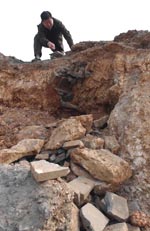Eager to finish the first stage of a key project before September, the unit in charge of constructing the Xinxiang City residential waste disposal plant began working without obtaining clearance from the local cultural relics protection authorities.
As a result, 23 Han Dynasty (206 BC - AD 220) tombs were destroyed and seven others buried under the garbage disposal plant site.
Although most of the Han Dynasty Wangmen Village tombs were leveled, the local Cultural Relics Bureau managed to salvage immediately nearly three dozen precious relics, including iron swords and various pottery pieces. A pottery xiao, or ocarina, decorated with owl-shaped veins, was considered a particularly rare find.
Zhang Biquan, the director of the Culture Relics Administrative Committee of Fengquan District, Xinxiang, said that the municipal culture relics protection unit had determined that a number of Han Dynasty tombs were clustered in the area, about 10 kilometers north of Xinxiang. Beneath the 30-hectare site where the garbage disposal plant is being constructed, Zhang estimates, are more than 1,000 ancient tombs.
Beginning in October last year, he visited the Xinxiang Urban Administration Bureau's Public Sanitation Department several times, asking them to allow an archeological survey before beginning construction. But the department repeatedly put off his proposal.
In late March, the sanitation department broke ground on the construction project. The Cultural Relics Administrative Committee demanded that they stop, but the construction went on.

Xinxiang's residential waste disposal plant is a key project for the city and an important one for Henan Province. According to Mao Yanzhuang, vice director of the Public Sanitation Department, Xinxiang residents generate 700 tons of waste per day. It has always simply been buried outside the city, with a negative impact on the environment there. Thus, 116.9 million yuan (US$14 million) was allocated to build the new facility.
Because Xinxiang wants to apply for a state-level sanitation certification, time was limited. They hoped they could begin construction while the archeological survey was being conducted.
Lian Weiliang, leader of the Xinxiang Municipal Party Committee, ordered that the Public Sanitation Department proceed in accordance with China's Cultural Relics Protection Law. Construction was halted on March 29. The archeological survey team, waiting at the site for the go-ahead, began their work, salvaging and evaluating what was left of the tombs.
Zhang Biquan said the team has worked diligently during its two weeks on the site. They have delivered the relics salvaged so far to Xinxiang's Hanfeng Museum for safekeeping.
Wang Chunling, who is in charge of the team, said that by April 14, the team had probed more than 20 of the tombs. Most of them belonged to commoners who lived during Han Dynasty. Some of the tombs had previously been broken into by thieves, further complicating the team's work. Nevertheless, she said, they are thrilled to have found more than 50 items, mostly made of pottery or bronze, in one tomb alone.
Wang estimates that her team will need about one more month to complete its work. Construction of the waste disposal plant will then resume.
(China.org.cn April by Chen Lin, 15, 2004)

